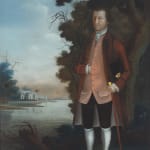Spoilum (active 1774-1805)
Portrait of Captain John Corner of the East Indiaman Carnatic, circa 1775
reverse-glass painting with oils and gold leaf highlights
26.7 x 20.3 cm
10 ½ x 8 in
In original wooden frame
10 ½ x 8 in
In original wooden frame
7162
Further images
Provenance
Presumably (given the handwritten label on the back board) with the descendants of the Captain John Corner until at least 1879Acquired by Martyn Gregory, London, by 2009
Exhibitions
Martyn Gregory, Paintings of the China Trade; Historical pictures by Chinese and Western artists 1780-1980, catalogue 85, London, 2009/2010, p.91, no.100Literature
T. Audric, Chinese reverse glass painting 1720-1820: an artistic meeting between China and the West, Bern, 2020, pp.130, 206-207, no.85/297
Reverse painting in oil and gold paint on glass, a label attached to the old backboard, handwritten in ink, reads 'This painting on glass, done in China, is the portrait...
Reverse painting in oil and gold paint on glass, a label attached to the old backboard, handwritten in ink, reads 'This painting on glass, done in China, is the portrait of John Corner Esq., Captain of his own ship The Carnatic. He was the eldest son of William Corner Esq. And Ruth Corner, London. He married the daughter and heiress of W. House, but died without children. He adopted his wife's sister's son, afterwards the Revd. Frank Rivers of the Church of Knightsbridge, London. This portrait was taken more than a hundred years ago. 1879', original wood frame.
John Corner (c.1750-1816) first sailed to the East as a young officer aboard the York, which made four voyages to India and China between 1767 and 1776. Between 1780 and 1783 he captained the East India Company's packet Fox, making two eastern voyages; he then made two voyages to Canton as Captain of the Carnatic, an 1169-ton Indiaman built in 1787 by John Randall of Rotherhithe, the first of these from October 1788 to January 1789, and the second from September to December 1791.
The Carnatic made four more voyages to China. In 1792, under the command of Captain James Jackson, the ship carried back to England two varieties of camellia (the double white Alba Plena and the double striped Variegata) which may be said to have initiated the vogue for camellias in Britain. They were brought back from China for John and Gilbert Slater; the latter was the principal owner of the Carnatic, and was also responsible for importing the rose known as 'Slater's Crimson China', one of the four 'stud Chinas' from which many modern roses are descended.
The Cantonese artist known to Westerners as Spoilum was the first Chinese export artist to establish an individual style which can be recognised today. His earliest documented work is a reverse-glass painting of Captain Thomas Fry, dated 1774, which like the present portrait shows the subject full-length against a background of sea and a rocky coast; for a similar composition see https://www.coulborn.com/artworks/categories/7/1974-spoilum-active-1774-1805-portrait-of-a-western-man-in-a-chinese/ . It is clear however that Spoilum was not the only Cantonese artist painting portraits on glass for Western clients at this time. Nothing is known of the artist or his studio apart from a handful of documented pictures and literary references, so it is difficult to distinguish with certainty between the work of Spoilum and that of his colleagues. See P.Conner, 'The Enigma of Spoilum and the origins of China trade painting', The Magazine Antiques CLIII no.3, March 1998, pp. 419-425.
Having worked as a painter of reverse portraits on glass in the 1770s, Spoilum evidently adopted the medium of oils on canvas in the following decade. He portrayed Chinese officials as well as the Western merchants and ships' officers who came to Canton during the trading season.
John Corner (c.1750-1816) first sailed to the East as a young officer aboard the York, which made four voyages to India and China between 1767 and 1776. Between 1780 and 1783 he captained the East India Company's packet Fox, making two eastern voyages; he then made two voyages to Canton as Captain of the Carnatic, an 1169-ton Indiaman built in 1787 by John Randall of Rotherhithe, the first of these from October 1788 to January 1789, and the second from September to December 1791.
The Carnatic made four more voyages to China. In 1792, under the command of Captain James Jackson, the ship carried back to England two varieties of camellia (the double white Alba Plena and the double striped Variegata) which may be said to have initiated the vogue for camellias in Britain. They were brought back from China for John and Gilbert Slater; the latter was the principal owner of the Carnatic, and was also responsible for importing the rose known as 'Slater's Crimson China', one of the four 'stud Chinas' from which many modern roses are descended.
The Cantonese artist known to Westerners as Spoilum was the first Chinese export artist to establish an individual style which can be recognised today. His earliest documented work is a reverse-glass painting of Captain Thomas Fry, dated 1774, which like the present portrait shows the subject full-length against a background of sea and a rocky coast; for a similar composition see https://www.coulborn.com/artworks/categories/7/1974-spoilum-active-1774-1805-portrait-of-a-western-man-in-a-chinese/ . It is clear however that Spoilum was not the only Cantonese artist painting portraits on glass for Western clients at this time. Nothing is known of the artist or his studio apart from a handful of documented pictures and literary references, so it is difficult to distinguish with certainty between the work of Spoilum and that of his colleagues. See P.Conner, 'The Enigma of Spoilum and the origins of China trade painting', The Magazine Antiques CLIII no.3, March 1998, pp. 419-425.
Having worked as a painter of reverse portraits on glass in the 1770s, Spoilum evidently adopted the medium of oils on canvas in the following decade. He portrayed Chinese officials as well as the Western merchants and ships' officers who came to Canton during the trading season.








